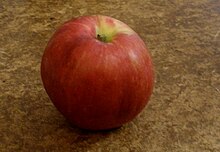| Esopus Spitzenburg | |
|---|---|
 | |
| Genus | Malus |
| Species | Malus domestica |
| Cultivar | Esopus Spitzenburg or Aesopus Spitzenburgh |
| Origin | Found on a tree in Esopus, New York, United States - late 18th century |
Esopus Spitzenburg or Aesopus Spitzenburgh [1] [2] is a variety of apple. It was discovered early in the 18th century near Esopus, Hudson, New York and is reputed to have been a favorite apple of Thomas Jefferson, who planted several of the trees at Monticello. [3]
In 1922, Ulysses Hedrick described Esopus Spitzenburg (sometimes simply called "Spitzenberg") as "one of the leading American apples ... [A]bout the best to eat out of hand, and very good for all culinary purposes as well." [4] In particular, it is a good apple for baking pies and is also valued as a cider apple. [5]
It is fairly large, oblong and has yellow ground color and red overcolor. Flesh yellow firm crisp, juicy. Typical size according to Warder [6] width 73 mm, height 75 mm, according to Downing [7] width 77 mm, height 68 mm. Stalk three-fourths of an inch, slender, inserted in a wide cavity. Calyx small, and closed set in a shallow basin. Like many late-season apples, it improves with a few weeks of cool storage, which brings it to its full, rich flavor. Hedrick praised this apple as attractive and keeping well in cold storage, but added that it was imperfect in that the trees lack vigor and are vulnerable to apple scab. [5] Its young shoots are rather slender, of a dark color. It is distinguished not only by this, but the form of its fruit, and its superior productiveness from the Flushing Spitzenberg. [8] This cultivar is suitable for hardiness zones 4–7 and should be grown in full sun. [9] However, the trees grow unevenly and sometimes the upper branches shade out the lower ones, which can be frustrating to the orcharder. It also has a biennial bearing tendency, and is susceptible to any available apple disease. [10] This cultivar is a direct lineal descendant of Reinette Franche (8). Esopus Spitzenburg also gave rise to the cultivar Jonathan, which was used in the breeding of a great many apples (8,9)
Herman Melville mentioned this apple in " Bartleby, the Scrivener". [11]
| ---- | When to pick | When ripe enough to eat | Latest cold storage limit |
|---|---|---|---|
| Northern states | Oct. 4-23 | Nov. 15-25 | April 1 |
| Southern states | Sept. 13 - Oct. 3 | Oct. 25 - Nov. 15 | Feb. 15 |
See also
References
- ^ William, Kenrick, The new American Orchardist, Boston, 1833
- ^ Beach, S.A.; Booth, N.O.; Taylor, O.M. (1905), "Esopus Spitzenburg", The apples of New York, Albany: J. B. Lyon, pp. 120–122
- ^ Hatch, Peter J. (January 1995). "Esopus Spitzenburg: Connoiseur Fruit". Twinleaf Journal. Virginia: Thomas Jefferson Foundation. Archived from the original on 2012-04-04. Retrieved 2011-10-15.
- ^ Hedrick, Ulysses Prentiss (1922). Cyclopedia of Hardy Fruits. New York: Macmillan Publishers. OCLC 3714494.
- ^ a b Karp, David (2004-10-20). "Apples with Pedigrees Selling in Urban Edens". The New York Times. New York. Retrieved 2009-09-16.
- ^ Warder, American Pomology
- ^ Downing, Fruits and fruit-trees of America, 1885
- ^ William Kenrick, The new American Orchardist, Boston, 1833
- ^ "In Bloom at Monticello: Malus cv 'Esopus Spitzenburg'". Thomas Jefferson Foundation. Archived from the original on 2012-04-04. Retrieved 2011-10-15.
- ^ Esopus-Spitzenberg at Orange Pippin
- ^ Herman Melville: Bartleby, the Scrivener, Putnam’s Monthly Magazine 2, November 1853, p. 549
- ^ Stark Nurseries, Catalog, 1917
8 Muranty, H., Denancé, C., Feugey, L., Crépin, J. L., Barbier, Y., Tartarini, S., … Durel, C. E. (2020). Using whole-genome SNP data to reconstruct a large multi-generation pedigree in apple germplasm. BMC Plant Biology, 20(1), 1–18. https://doi.org/10.1186/s12870-019-2171-6
9 Noiton, D. A. M., & Alspach, P. A. (1996). Founding clones, inbreeding, coancestry, and status number of modern apple cultivars. Journal of the American Society for Horticultural Science, 121(5), 773–782. https://doi.org/10.21273/jashs.121.5.773
External links
- "Esopus Spitzenburg", National Fruit Collection, University of Reading and Brogdale Collections, retrieved 17 October 2015
